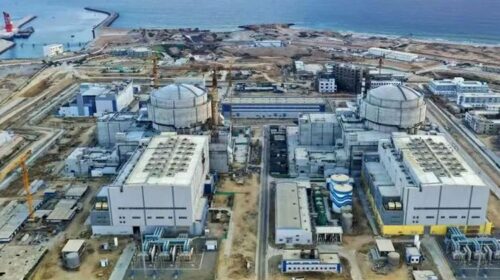Pakistan has successfully connected its second 1,100 megawatt (MW) nuclear power plant unit to the national power grid which will provide clean and affordable electricity to millions.
Pakistan Atomic Energy Commission (PAEC) confirmed that it connected the K-3 unit of the Karachi nuclear power plant (KANUPP) to the national grid. “The plant has been connected to the grid on a testing basis and is expected to be inaugurated soon after attaining full power.” The plant had achieved criticality on February 21.
The K-3 unit “will generate nearly 10 billion kWh of electricity annually” and produce enough electricity to power 4 million households in Pakistan, according to a statement by the Chinese embassy. “It is equivalent to reducing the use of standard coal by 3.12 million tons and reducing carbon dioxide emissions by 8.16 million tons per year. It is of great significance for optimising Pakistan’s energy structure and reaching carbon peak and carbon neutrality goals,” the statement added.
The K-2 and K-3 reactor units, near the coastal city of Karachi, are powered by the Chinese Hualong One (HPR100) technology, a pressurised water reactor. Both units will each consist of a nuclear island, conventional island and balance of plant. The units are designed to have a 60-year lifespan.
K-2 and K-3 units
K-3 is the second nuclear power plant in Pakistan with a generation capacity of 1,100MW and would help meet the rising electricity demand in the country of 220 million. The other 1,100MW K-2 unit was inaugurated by Prime Minister Imran Khan in May last year. “Nuclear energy is safe, reliable, and an important source of electricity with zero carbon emission besides being economically competitive,” the PAEC said.
Nuclear energy
Pakistan now has seven operational nuclear power stations and the successful addition of K-3 would take the country’s nuclear power generation capacity from an estimated 2,530MW to over 3,600MW. The new units would help meet the electricity demand, which is around 25,000MW in the summertime peak and 12,000MW in the winter.
Pakistan’s energy mix
Pakistan’s current energy mix is formed of about 58 per cent fossil fuels, 30 per cent hydropower and 10 per cent renewables and nuclear power. Pakistan’s prime minister has vowed that by 2030 Pakistan would produce 60 per cent of its electricity from renewable sources. The country has a planned nuclear power generation capacity of 40,000MW by 2050.







